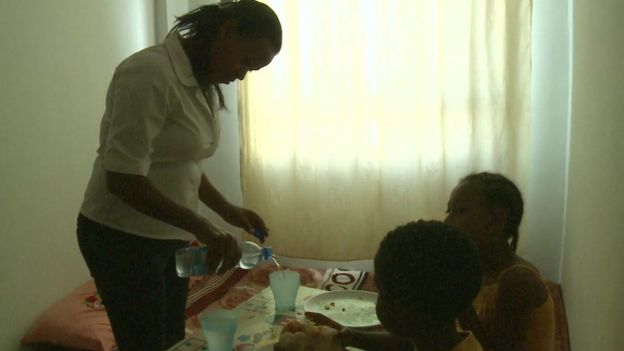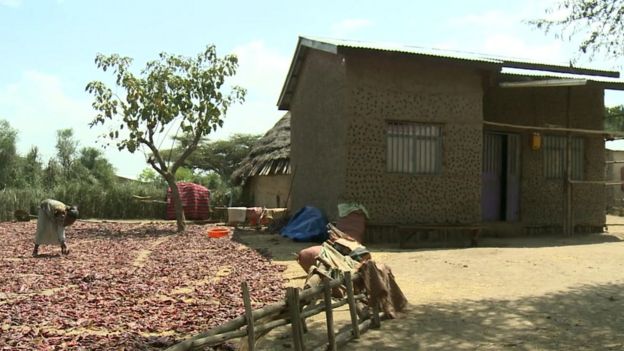Ethiopia has seen a massive cut in its fertility rate, from an average of seven children per woman in the 1990s to 4.6 currently. But how has it managed this?
Experts say the country has made this turnaround because of a combination of factors.
"Women stay longer in school, the standard of living is increasing so people don't want to have too many children and more importantly, family planning is becoming more popular," explains Faustin Yao, the United Nation Population Fund (UNFPA) representative to Ethiopia.
The country's economy is among the fastest growing in the world, and as the quality of life improves, people tend to have fewer children.
Muluwork Tesfaye, a nurse in Addis Ababa, says she could not afford to support a large family in the capital.
The mother of two grew up in a family of eight and her parents struggled to provide for them.
"My husband is the one who took me to college," she says. "I wanted a better life for my children."

In the capital, Addis Ababa, the fertility rate is estimated to be 1.7 - lower than the rate needed to keep the population steady.
More educated women and a higher cost of living often mean fertility rates are lower in urban areas.
Contraception
In Ethiopia, the availability of contraceptives has also played a big role.
"The increase in contraceptive use during 2000-2011 emerged as the single most important source for the recorded decline in TFR (Total Fertility Rate)," said a UNFPA report.
However, a quarter of all women who need contraceptives are still not able to get them.
Rural areas have also recorded a decline in the number of children per woman, albeit slower.
Ayenalem Daw, a mother of six living in Weyo Rafu Hargisa village about a four-hour-drive out of Addis Ababa, is in her late thirties.
She says if she had heard about family planning earlier, she would have had four children.

Women in her village hold regular meetings called "shene" to discuss contraception and other health issues.
"Things are changing now. I think my children will have only two babies each," says Mrs Ayenalem.
Health extension workers also regularly provide health education in the villages, including information about contraception to those who need it.
The programme entails home visits by government-employed community workers who engage families on a one-on-one basis.
The big leap in contraception use between 2000 and 2011 is largely attributed to health extension workers.
This was also helped by an increase in the number of girls going to school over the same period.
"We go to the churches and mosques to talk to people about family planning," said one of the women in the village of Hunta, in the Oromiya region.
While it is known that the major religions in Ethiopia - Orthodox and Muslims - do not openly approve of family planning, the health workers said religious leaders were generally supportive of their work.
Ethiopia is among nine African countries whose rate of population growth is declining.

Others are Ghana, Kenya, Madagascar, Rwanda, Senegal, Tanzania, Togo and Uganda.
But many other African countries whose fertility decline was on course have now stalled, while others are yet to begin the transition.
Most dangerous place to give birth:
Mandera - a vast, arid county on the north-eastern Kenyan tip bordering Somalia and Ethiopia - has one of the world's highest fertility rates. On average, a woman there gives birth to eight children.
But it is also one of the world's most dangerous places for a woman to give birth.
The UN Population Fund estimates that 3,795 women die giving birth out of every 100,000 live births. The national average is more than 10 times smaller.
Early marriage, female genital mutilation, low education levels especially for women, underdeveloped healthcare infrastructure contribute to the dire situation.
Local leaders are now keen on changing this trend by inviting foreign partners to invest in healthcare.
"Resources are everything," said Mandera governor Ali Roba.
"We have a lot of competing interests; virtually every sector in Mandera is in dire need of attention."
They are optimistic the rate will come down and when it does, so will the fertility rate.
'Extreme poverty'
Experts say reducing poverty rates also leads to a decline in fertility.
"It's not the population growth that is the problem - it's the extreme poverty that is the underlying reason," says Hans Rosling, professor of international health at the Karolinska Institute in Sweden.
"If you continue to have extreme poverty areas where women give birth to six children and the population doubles in one generation, then you'll have problems."
A case in point is Niger, the country with the highest fertility rate in the world - 7.6. It is also one of the poorest.

The West African country is projected to nearly quadruple its population from about 17 million to 66 million between now and 2050.
Experts warn that this trend could only spell more trouble for Nigeriens, half of whom are already without adequate food and who are often hit by drought.
For Africa to effectively eradicate poverty, countries will have to take deliberate steps to manage the rate of their population growth.
Some, like Ethiopia, are leading the way and reaping the benefits of having smaller families.
No comments:
Post a Comment